Current Diagnosis and Management of Multiple Myeloma
The availability of a wide variety of treatments for multiple myeloma allows healthcare providers to tailor treatments to individual patient needs, and has enabled prolonged survival of patients with the disease.
ABSTRACT: The availability of a wide variety of treatments for multiple myeloma allows healthcare providers to tailor treatments to individual patient needs, and has enabled prolonged survival of patients with the disease. Improved understanding of the disease, its treatment options, and potential side effects of therapy has provided unique opportunities for oncology nurses to employ preventive approaches, care strategies, and patient and family education and support over time. Because therapies have been developed that prolong the survival time, people with multiple myeloma are in the position of living with the disease for many years. Additional challenges are presented as healthcare providers develop wellness and quality of life plans of care in the setting of multiple myeloma survivorship. This article will explore the diagnosis, treatment planning, and clinical management of patients with multiple myeloma.
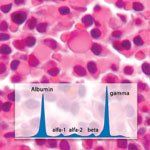
Multiple myeloma (myeloma) is a malignant disorder of the mature B plasma cell.[1] It can be considered a bone marrow disorder, and like leukemia, it prevents normal hematopoiesis and bone marrow function. This results in anemia, thrombocytopenia, and neutropenia. Unique to myeloma is the ability of the myeloma cell to cause problems such as cavitary bone lesions, hypercalcemia, renal failure, and solid plasmacytomas. Normal plasma cells produce normal immunoglobins. In patients with myeloma, abnormal or fragmented immunoglobin chains are secreted, often causing problems due to deposition in the body, particularly in the kidneys.
Multiple myeloma accounts for only about 1.3% of all malignancies in the United States. The American Cancer Society has estimated that about 20,180 new cases of multiple myeloma were diagnosed in the US in 2010, with an estimated 10,650 deaths.[2] The mean age of affected individuals is 62 years for men and 61 years for women, with less than 2% of cases occurring in patients younger than 40 years old. It is the second most common hematologic malignancy in the United States, second only to non-Hodgkin’s lymphoma if all subtypes are considered.[2,3]
Like many cancers, the exact cause of myeloma is not known. Age is a predominant factor. The incidence is higher in men and twice as high in African Americans. Genetic factors are implicated in familial trends.[4]
Myeloma is considered not curable, but treatment advances have improved the survival. Prior to the introduction of melphalan and prednisone in the 1960s, the survival time was less than a year.[5] Autologous stem cell transplant was introduced in the 1980s, further improving survival. The introduction of therapies such as thalidomide (Thalomid), lenalidomide (Revlimid), and bortezomib (Velcade) has also contributed to improved outcome of patients with myeloma in recent years, both in the relapsed-disease setting and at initial diagnosis. An overall survival time of 44.8 months has been reported,[5] and some patients are living up to 10 years from initial diagnosis.[3]
DIAGNOSIS
Although approximately 20% of all myeloma patients are diagnosed while they are completely asymptomatic, patients with symptomatic active disease will present with bone pain, fatigue, weight loss, and paresthesias.[6] The most common clinical features at presentation are anemia, lytic bone lesions, renal insufficiency, hypercalcemia, and infection.[7]
TABLE 1
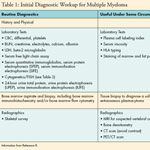
Initial Diagnostic Workup for Multiple Myeloma
Initial diagnostic workup includes the items in Table 1. LDH levels help with assessment of tumor cell burden, and the level of beta-2 microglobulin is now considered a standard measure of the myeloma tumor burden.[8] Blood serum analysis also includes quantitative immunoglobulin testing to determine levels of the different types of abnormal antibodies. Assessing the changes and amounts of the immunoglobins in the serum and urine is often helpful in tracking the progression of myeloma disease, although some patients have myeloma that does not secrete abnormal immunoglobins. For those who do, this is often referred to as the “M-spike,” as the monoclonal myeloma protein shows a spike on the plasma electrophoresis test results. The serum free light chain assay has prognostic value for myeloma as well as other plasma cell disorders, including monoclonal gammopathy of undetermined significance (MGUS), smoldering myeloma, immunoglobulin light chain amyloidosis, and solitary plasmacytoma.[8]
TABLE 2
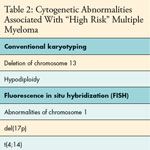
Cytogenetic Abnormalities Associated With “High Risk” Multiple Myeloma TABLE 3

Definition of Multiple Myeloma TABLE 4
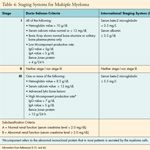
Staging Systems for Multiple Myeloma TABLE 5
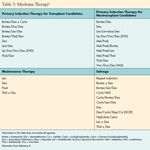
Myeloma Therapy TABLE 6
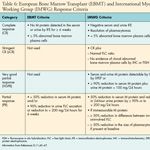
European Bone Marrow Transplant (EBMT) and International Myeloma Working Group (IMWG) Response Criteria
Along with the diagnostic staging and patient-specific comorbid conditions (such as renal failure, diabetes, heart conditions, etc), cytogenetic markers may be used on an individual basis to determine the best therapy for a given patient. Cytogenetic tests evaluate whole chromosomes from the nucleus of the cell at the time of mitotic metaphase. This helps to determine the changes in number or structure of chromosomes. One drawback of conventional cytogenetic testing (karyotyping) in myeloma is that the myeloma cells have a low proliferative activity, and it may take up to 2 weeks to receive complete results. Fluorescence in situ hybridization (FISH) is more sensitive but also more expensive.[9–11]
A number of these genetic abnormalities, cytokines, and serum tumor markers have been implicated in the pathogenesis and risk-stratification of myeloma. Although some cytogenetic testing may be done at initial diagnosis, the results are not incorporated into response criteria.[11] Table 2 lists some of the cytogenetic abnormalities that have a negative prognostic implication.
Based on the results of the clinical and laboratory evaluation, patients are initially classified as to whether they have smoldering (asymptomatic) or active (symptomatic) disease. Table 3 highlights definitions of smoldering and active myeloma that may affect treatment decisions.
The first multiple myeloma classification system was published by Durie and Salmon in 1975.[12] The second classification system, the International Staging System for Multiple Myeloma (ISS) is used more commonly in the clinical setting (see Table 4).
Treatment is an induction chemotherapy. This is often a multiagent combination chemotherapy. In selected patients, it is followed by high-dose chemotherapy and autologous hematopoietic stem cell transplant (HSCT). In general, if a patient is a potential HSCT candidate, agents that may later affect stem cell function, such as nitrosoureas or alkylating agents (eg, melphalan or prolonged use of lenalidomide), should be avoided up front. Reduced-intensity or mini-allogeneic transplants have been investigated as therapy following autologous HSCT and as salvage therapy for selected patients.[8] Some patients may be referred to an appropriate clinical trial. In general, different treatment modalities are used over time.
The National Comprehensive Cancer Network (NCCN) has developed clinical guidelines for myeloma treatment.[8] Table 5 describes the common regimens that are used.
Two different response criteria are used to determine the effectiveness of treatment for multiple myeloma. These are described in Table 6.
Myeloma treatment guidelines reflect improvement not only in targeted therapies, but also in supportive care strategies, such as hematopoietic growth factors, blood component support, antibiotics, and antihypercalcemia drugs. Bone disease, renal dysfunction, and other complications such as hypercalcemia, hyperviscosity, and coagulation/thrombosis should be treated with appropriate adjunctive measures.[8]
Nurses have a unique opportunity and challenge to assimilate knowledge about these therapies, disease manifestations, and individual patient comorbidities to collaboratively develop a comprehensive patient care plan with the healthcare team. The section that follows relates to the nursing care of patients with multiple myeloma.
NURSING CONSIDERATIONS
Bone Problems
Skeletal involvement affects nearly 70% of myeloma patients during the course of their disease.[13] Patients with myeloma may have osteolytic or cavitary bone lesions, which may lead to fractures and/or spinal cord compression. Because the myeloma cell produces osteoclast-activating factors (OAFs), there is an upregulation of osteoclast activity. Hypercalcemia is also common.
All patients with documented bone disease should be given a bisphosphonate (pamidronate [Aredia] or zoledronic acid [Zometa]) monthly. It may also be given preventively for patients with osteopenia or osteoporosis.[6,8] The major side effects with prolonged use include renal insufficiency, hypocalcemia, and osteonecrosis of the jaw. Because of the latter, patients should have a comprehensive dental evaluation before receiving any bisphosphonate treatment. They should be instructed to practice good dental hygiene and speak with their oncologists before undergoing any invasive dental procedure.[6] Serum calcium should be routinely monitored; hypercalcemia may be treated with hydration, calcitonin, diuretics, and/or steroids.[8]
Because the osteopenia and lytic lesions place the patient at high risk for fractures, it is crucial that oncology nurses know the number and sites of lytic lesions, to determine whether a patient is at risk for spontaneous pathologic fracture. Orthopedic consultation should be sought for impending or actual long-bone fractures, bony compression of the spinal cord, or any vertebral column instability.
Treatment may include kyphoplasty (vertebroplasty) and/or stabilizing surgery. Percutaneous vertebroplasty is guided by fluoroscopy or CT, with the patient under sedation. An acrylic cement is injected into the malignant bone cavity, thereby strengthening the vertebra(e) and preventing further compression of the myeloma-cavitated body.[14] Prior to the procedure, the patient should have coagulation factors (PT [prothrombin time]/PTT [partial thromboplastin time]) and platelet count checked and corrected if necessary. Nurses need to ensure that the patient and family are informed about any functional limitations that may occur because of pathologic bone lesions. Although even minor movements by the patient alone-such as turning in bed or lifting a shopping bag-can lead to a spontaneous fracture, all healthcare staff need to make sure that the patient is not turned or moved in a way that may contribute to a fracture.
Maintaining and improving physical functioning should be part of the patient’s treatment plan. Exercise training is safe during and after cancer treatment, and it results in improvements in physical functioning, quality of life, and cancer-related fatigue.[15] As with other individuals age 65 years and older, patients with myeloma have particular risk factors related to falls (eg, visual problems, orthostatic hypotension, problems with gait and balance). In 2006, the Centers for Disease Control and Prevention (CDC) estimated that approximately 16% of all US adults in that age group fell at least once, and 31% of those who fell sustained an injury.[16] Assessment of safe mobility should be performed continually, as maximizing balance and strength can reduce the patient’s risk of falls. Exercise prescriptions should be individualized according to the patient’s disease, pretreatment level of aerobic fitness, medical comorbidities, response to treatment, and the immediate or persistent negative effects of treatment that are experienced at any given time.[15]
When recommending activity to patients with myeloma, fracture risk and limitations that may imposed by existing neuropathies, in particular, need to be taken into account. Steroids, a very common component of the treatment plan for myeloma, can cause a wide range of moderate to life-threatening side effects. Those that can affect mobility include proximal myopathy or muscle weakness, weight gain, visual changes, osteoporosis, and osteonecrosis.[17]
At every encounter, nurses should evaluate myeloma patients’ abilities to perform activities of daily living in a safe manner, so that falls and fractures are avoided. The nurse should ensure that appropriate referrals are made to rehabilitation physicians or physical therapists or, minimally, that an activity or exercise program is prescribed.
Pain
Bone pain is the most common presenting symptom in patients with myeloma, and it can occur at any time during the course of the disease. It is often a significant problem. Besides affecting quality of life and function, bone pain can indicate an oncologic emergency, signaling an impending or actual fracture and/or spinal cord compression, or infection. Pain from skeletal lesions occurs in 67% of myeloma patients.[18] Neuropathic pain from the disease alone occurs in up to 13% of patients, with the reported rate as high as 54%, as a result of treatment with novel therapies, especially thalidomide, bortezomib, and lenalidomide.[19,20] Comorbid conditions such as diabetes, HIV infection, alcoholism, and herpes zoster can contribute to neuropathic pain. Patients may report symptoms of burning pain; having a limb “fall asleep”; and various sensations such as burning, stabbing, stinging, squeezing, aching, cramping, shooting pain, and cold.[21]
Nurses are in a unique position to assess and explore pain in a stepwise and ongoing fashion, using verbal and nonverbal pain scales and grading systems. This will help to ensure that the patient receives adequate pain control and ongoing assessment and intervention. Neurophysiologic testing, X-rays, and other diagnostics may be needed to further ascertain or confirm the etiology of the pain. Depending on the type of pain or pain syndromes, one or more therapies may be prescribed. For mild pain (patient report of levels 1–3 on a 0–10 scale), nonsteroidal anti-inflammatory drugs (NSAIDs) or acetaminophen may be prescribed. However, patients should be cautioned about the renal, gastrointestinal, and bleeding toxicities associated with NSAIDs, and the liver toxicity of acetaminophen. In general, cancer pain is treated with opioids, and additional interventions are meant to complement management. For example, the addition of bisphosphonates, a nerve block, and/or steroids may be helpful for bone pain.[22] Antiepileptic drugs such as gabapentin or pregabalin (Lyrica) and tricyclic antidepressants such as amitryptyline or duloxetine (Cymbalta) may be helpful for neuropathic pain.[21,23] The lidocaine patch 5% (Lidoderm) may also be used. Nonpharmacologic interventions can include supportive braces, physical therapy, massage, acupuncture/acupressure, imagery, application of cold/heat, and others. Side effects from the medications, such as constipation, nausea, pruritus, motor and cognitive impairment, and sedation should be prevented or controlled. For all levels of pain, psychosocial support and patient and family education should be employed, as well as consideration of coanalgesics (antidepressants, topicals, etc) and nonpharmacologic interventions.[22]
Low-dose radiation therapy (10–30 Gy) can be used as palliative treatment for uncontrolled pain, impending pathologic fracture, or impending cord compression.[22] As previously stated, vertebroplasty or kyphoplasty for symptomatic vertebral compression fractures can be helpful to reduce pain and the risk of further injury.
Infection
Patients with myeloma may have pre-existing myelosuppression as a result of the bone marrow being replaced by malignant plasma cells. In addition, most therapies have the potential to cause some degree of myelosuppression.[24,25] The incidence of neutropenia (all grades) is dependent upon the therapy administered, as well as pre-existing myelosuppression from the disease within the bone marrow.
TABLE 7
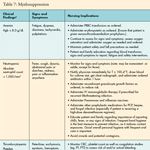
Myelosuppression
Because myeloma patients may not produce enough normal plasma cells and immunoglobulins, infections can occur from this deficit as well. Renal insufficiency caused by myeloma can also lead to decreased levels of the red blood cell (RBC) growth hormone, erythropoietin, reducing RBC production.[26] Table 7 proposes nursing care strategies for multiple myeloma patients who have myelosuppression.
Gastrointestinal Problems
Gastrointestinal side effects of therapy for myeloma may include oral and bowel mucositis, constipation, diarrhea, nausea, and vomiting.[27] Although these effects are fairly predictable and manageable, they can become life-threatening. For example, severe diarrhea due to bowel mucositis from high-dose chemotherapy can lead to electrolyte disorders and intestinal inflammation-and even bowel perforation in extreme cases. Comorbidities can exacerbate these problems. For example, patients taking thalidomide may have up to a 55% risk of constipation.[27] Added to this, if the patient is sedentary because of pain and is taking opioid medications, constipation could become severe. Certainly, even if not physically serious, these symptoms can interfere with quality of life. Intensive therapy, such as during high-dose chemotherapy and autologous stem cell transplant, generally causes a temporary decline in nutritional status and health-related quality of life.[28]
TABLE 8

Steroid-Related Side Effects
Nursing management of gastrointestinal problems in myeloma is the same as that for other cancer patients with these symptoms. The healthcare team should thoroughly assess a patient’s ability to eat and drink, the presence of nausea and/or vomiting, bowel habits, and any changes that have occurred. Pertinent physical exams and laboratory radiologic examinations need to be done that would indicate fluid and electrolyte or bowel abnormalities. Coexisting factors need to be included in the assessment and plan of care, including dietary patterns, medications taken, and physical activity. Patient and family education is extremely important, as well as medication intervention, such as a bowel regimen to prevent constipation, or antinausea and antidiarrheal medications.
Steroids
Steroids are lympholytic and are a main component of most therapy for myeloma. They can affect almost any body system, and side effects from their use are listed in Table 8.[17] These side effects can be exacerbated by comorbid conditions, such as neuropathy from other myeloma therapies and from the myeloma itself, pre-existing conditions such as diabetes, and others.
Discussion of all interventions for steroid-related side effects is beyond the scope of this manuscript. However, nurses should apply appropriate interventions, including patient and family education, if the side effects occur. For example, the patient should be instructed to have regular eye exams, to screen for vision changes and cataract formation. Patients should be instructed to take the steroid in the morning rather than later in the day if hyperactivity is a problem. The importance of maintaining excellent hygiene should be emphasized, as the immunosuppressive effect of steroids increases the risk of infection. Skin thinning can also lead to easy skin tears and wounds. The patient and family should be instructed to call the patient’s healthcare provider if any signs or symptoms of infection occur. Certain side effects warrant that the patient be referred to a specialist, such as an endocrinologist if the hyperglycemia is not under control, or a psychotherapist if psychological and/or sexual problems occur.
Thromboembolic Events
Thromboembolic events (TE), including deep vein thrombosis (DVT) and pulmonary embolism (PE), can affect the myeloma patient. Patients with cancer are generally at higher risk for a TE, compared with individuals without cancer, and patients with myeloma may incur TEs at an even higher incidence.[29,30] Patients with myeloma are at risk because of individual risk factors, as well as antimyeloma treatment agents. For example, obesity, immobility, smoking, chronic renal disease, diabetes, and estrogenic agents add to the risk of TEs.[31]
In some patients, the presence of a hyperviscosity syndrome may increase the risk of TEs even further. Up to 5% of patients have a hyperviscosity syndrome; it occurs most commonly in those with the IgM subclass of myeloma.[13,32] The blood is so viscous that it starts to inhibit blood flow to vital organs, such as the brain and kidneys. In hyperviscosity syndrome, the myeloma patient may present with neurologic abnormalities, vision changes, and mucosal bleeding; in some cases, the syndrome can lead to seizures and coma. Heart failure symptoms (eg, dyspnea, chest pain, etc) also may be present.[32] Physical findings in combination with serum viscosity levels 45 cp (centipoises) or higher (normal range: 1.4–1.8 cp) are used to confirm suspect hyperviscosity. Serum hyperproteinemia is present, and a peripheral blood smear may reveal rouleaux formation of red cells (resembling a pile of coins). This situation is considered a medical emergency. Aggressive hydration, diuresis, and emergent placement of an apheresis catheter usually are required, followed by plasma exchange to reduce blood viscosity (by decreasing the immunoglobulin concentration).[8,32]
Nurses should ascertain a particular patient’s risk for TEs at any given time throughout the care trajectory. In general, unless the patient is very active physically, hospitalized patients should be prescribed a prophylactic anticoagulation therapy.[31,33] Prophylactic anticoagulation is recommended for all patients who are receiving thalidomide-based therapy or lenalidomide with dexamethasone.[8,33]
Selected Education and Support Resources for Patients With Myeloma, and Their Families
Renal Events
Renal insufficiency or failure occurs in up to 25% of patients with myeloma and is a poor prognostic factor of the disease.[13] The cause is multifactoral. It includes hyperuricemia and infiltration of the kidney by plasma cells; deposition of myeloma monoclonal light chains in the kidney; hyperviscosity; poor hydration and volume depletion; urinary tract infection and sepsis; and nephrotoxicity from certain antibiotics, NSAID medications, IV contrast dyes and bisphosphonates, hypercalcemia, and nephrocalcinosis.[13,32] Nursing care goals are to maintain or improve kidney function. The nurse needs to be judicious in making sure that interventions do not compound the problem, by reviewing a patient’s kidney function (laboratory values, intake and output, weight changes, presence of edema, etc.) prior to administration of medications and fluids. Patients need to be coached about the importance of fluid balance and cautioned regarding over-the-counter medications that can contribute to renal dysfunction, such as NSAIDs, as well as effects from IV contrast agents. Renal dialysis may be indicated for patients with chronic renal failure.
Emotional Issues/Quality of Life
From the moment of diagnosis, myeloma patients face serious life-altering decisions and realize that they are in for a lifelong battle against the disease. Patients with myeloma are living longer, often with pronounced symptoms either from the disease or treatment. These symptoms can substantially reduce their quality of life. Care aims are to treat the disease, prolong survival, and maximize the quality of life. Cancer survivors who are informed about their options and who feel they have more personal control over their decision-making and care generally perceive a higher quality of life than those who feel less informed and less in control.[34] Nurses can help to guide the myeloma patient and family through this long journey.
Unfortunately, few myeloma-specific randomized controlled trials include health-related quality of life as a study end point. However, inference can be made from research that has been done. These results can assist practitioners in developing myeloma-specific evidence-based quality-of-life plans of care.[35]
Studies that have been done in patients with hematologic malignancies as well as myeloma indicate that frequent symptoms experienced by patients that may contribute to reduced quality of life are fatigue, reduced role function, insomnia, and pain.[36] One study on cancer patients with bone metastases not only evaluated and confirmed patients’ reported issues regarding pain and mobility, but it also revealed that healthcare providers did not necessarily appreciate patients’ “worry” about loss of mobility, dependence on others, and disease progression.[37] Sherman and colleagues studied quality of life and psychosocial adjustment among myeloma patients undergoing autologous HSCT. Patients reported problems of physical well being, functional well being, moderate fatigue and pain, anxiety, depression, and cancer-related distress during stem cell collection. There was a worsening of transplant-related concerns, depression, and life-satisfaction after transplant; however, pain improved and social functioning was well preserved.[38] In a multivariate analysis, patients reported better overall quality of life and less depression before transplantation. During transplant, patients often report lack of appetite, fatigue, weakness, feeling sick, disturbed sleep, nausea, and diarrhea.[39] In a recent study, terminally ill cancer patients identified positive and negative domains that affected their quality of life. These included physical condition and symptoms, psychological status, existential concerns, relationships and support, quality of care, physical environment and living facilities, hobbies and daily activities, and finances; “physical condition and symptoms” and “relationships and support” were the two domains most often described as important.[40]
All of the patient-reported problems described are within the realm of ongoing nursing assessment and intervention as part of an interdisciplinary team. Understanding the disease and its treatments allows the practitioner to ask pointed questions as part of the assessment. For example, a particular patient may be eating very well because of steroids on one visit to the clinic, but may continue to have a substantial problem during and after an autologous transplant. Regardless of whether it is a temporary nutrition problem or not,[28] it should be addressed appropriately. Additionally, the meaning of quality of life for any patient may change over time, depending on the disease progression and treatment goals. Family participation and maintaining an income may be a priority at one point, whereas minimizing pain and reducing family burden may be a priority at the end of life.
Advocating quality of life for patients includes patient education and support and coaching them to be self-advocates. Along with providing verbal education, written handouts, and appropriate healthcare team referrals, the nurse can point the patient and family to a reputable national agency for support (see sidebar, “Selected Education and Support Resources for Patients With Myeloma, and Their Families”).
Engaging the patient and family is important. The National Comprehensive Cancer Network provides a list of “10 Resolutions for Cancer Survivors.”[41] Statements such as “I resolve to get moving,” “I resolve to learn about and practice healthy nutrition,” “I resolve to manage my fear of cancer recurrence,” and “I resolve to attend to my body’s need” are included. These may serve as a way to help patients explore opportunities to participate in their care, and to maximize their treatment benefit and well being.
CONCLUSION
Caring for the patient with myeloma has the potential to harness the very essence of nursing care. Nurses need to understand the pathology of the disease, the treatment, and potential side effects. The physical and psychosocial problems that the patient may experience over time most likely will change depending on the disease, its treatments, and complications. Astute and ongoing assessment is important, to develop a tailored plan of care. This care plan should employ preventive strategies, direct care, education, and support interventions over time. It needs to be modified, with priorities changed appropriately, over the trajectory of the disease. Educating and supporting the patient through the fears of initial diagnosis and ongoing treatment are a must if side effects are going to be managed well. Through exceptional care, oncology nurses can advocate for the patient with multiple myeloma to optimize treatment and quality of life outcomes.
Financial Disclosure:The author has no significant financial interest or other relationship with the manufacturers of any products or providers of any service mentioned in this article.
This article includes discussion of off-label use of the following FDA-approved products: calcitonin, gabapentin, amitriptyline, cisplatin, and etoposide. In addition, hematopoietic stem cell transplant, an investigational therapy, is mentioned but not discussed.
References:
References
1. Falco AM, Smith L, Sullivan E: The pathogenesis of multiple myeloma: Understanding the mechanisms of the bone marrow microenvironment. J Adv Pract Oncol 2(1):11â24, 2011.
2. Jemal A, Siegel R, Xu J, et al: Cancer Statistics, 2010. CA Cancer J Clin 60(5):277â300, 2010.
3. Raab MS, Podar K, Breitkreutz I, et al: Multiple myeloma. Lancet 374:324â339, 2009.
4. Gleason C: Epidemiology, in Tariman JD (ed): Multiple Myeloma: A Textbook for Nurses. Pittsburgh, PA, Oncology Nursing Society, 2010, pp 41â54.
5. Kumar SK, Rajkumar V, Dispenzieri A, et al: Improved survival in multiple myeloma and the impact of novel therapies. Blood 111(5): 2516â2520, 2008.
6. Katzel JA, Hari P, Vesole DH: Multiple myeloma: Charging toward a bright future. CA Cancer J Clin 57(5):301â318, 2007.
7. Rajkumar SV, Kyle RA: Multiple myeloma: Diagnosis and treatment. Mayo Clin Proc 80(10):1371â1382, 2005.
8. National Comprehensive Cancer Network. Clinical Practice guidelines in Oncology: Multiple Myeloma. V.1.2011.
9. Chari A, Osman K, McLean M, et al: Case study: A patient with multiple myeloma and high-risk cytogenetics. The Oncology Nurse 3(6 Suppl):4â12, 2010.
10. Avet-Loiseau H, Malard F, Campion L, et al: Translocation t(14:16) and multiple myeloma: Is it really an independent prognostic factor? Blood 117(6):2009â2011, 2011.
11. Kurtin SE: Laboratory measures for the diagnosis, clinical management, and evaluation of treatment response in multiple myeloma. J Adv Pract Oncol 1(3):197â206, 2010.
12. Durie BGM, Salmon SE: A clinical staging system for multiple myeloma. Cancer 36(9):842â854, 1975.
13. Mangan PA: Patient assessment, in Tariman JD (ed): Multiple Myeloma: A Textbook for Nurses. Pittsburgh, PA, Oncology Nursing Society, 2010, pp 55â75.
14. Lee B, Franklin I, Lewis JS, et al: The efficacy of percutaneous vertebroplasty for vertebral metastases associated with solid malignancies. Eur J Cancer 45(9):1597â1602, 2009.
15. Schmitz KH, Courneya KS, Matthews C, et al: American College of Sports Medicine Roundtable on Exercise Guidelines for Cancer Survivors. Med Sci Sports Exerc 42(7):1409â1426, 2010.
16. Centers for Disease Control and Prevention (CDC): Self-reported falls and fall-related injuries among persons aged ⥠65 years-United States, 2006. MMWR 57(9):225-229, 2008.
17. Faiman B, Bilotti, E, Mangan PA, et al: Steroid-associated side effects in patients with multiple myeloma: Consensus statement of the IMF Nurse Leadership Board. Clin J Oncol Nurs 12(3 Suppl):53â63, 2008.
18. Melton LJ, Kyle RA, Achenback SJ, et al: Fracture risk with multiple myeloma: A population-based study. J Bone Miner Res 20(3):487â493, 2005.
19. Tariman JD, Love G, McCullagh E, et al: Peripheral neuropathy associated with novel therapies in patients with multiple myeloma: Consensus statement of the IMF Nurse Leadership Board. Clin J Oncol Nurs 12(3 Suppl):29â36, 2008.
20. Visovksy C: Clinical assessment of chemotherapy-induced peripheral neuropathy: The road less traveled. J Adv Pract Oncol 1:31â38, 2010.
21. Abramowsky MC: Chemotherapy-induced neuropathic pain. J Adv Pract Oncol 1(4):279â283, 2010.
22. National Comprehensive Cancer Network: Clinical Practice Guidelines in Oncology: Adult Cancer Pain. V.1.2010. Available at: www.nccn.org.
23. Paice JA: Clinical challenges: Chemotherapy-induced peripheral neuropathy. Semin Oncol Nurs 25(2 Suppl 1):S8âS19, 2009.
24. Taber SS: Multiple myeloma: A review. The Oncology Nurse 3(3):50â54, 2010.
25. Miceli T, Colson K, Gavino M, et al: Myelosuppression associated with novel therapies in patients with multiple myeloma: Consensus statement of the IMF Nurse Leadership Board. Clin J Oncol Nurs 12(3 Suppl):13â19, 2008.
26. Silvestris F, Tucci M, Quatraro C, et al: Recent advances in understanding the pathogenesis of anemia in multiple myeloma. Int J Hematol 78(2):121â125, 2003.
27. Smith LC, Bertolotti P, Curran K, et al: Gastrointestinal side effects associated with novel therapies in patients with multiple myeloma: Consensus statement of the IMF Nurse Leadership Board. Clin J Oncol Nurs 12(3 Suppl):37â45, 2008.
28. Iversen PO, Wisloff F, Gulbrandsen N: Reduced nutritional status among multiple myeloma patients during treatment with high-dose chemotherapy and autologous stem cell support. Clin Nutr 29(4):488â491, 2010.
29. Palumbo A, Rajkumar SV, Dimopoulos MA, et al: Prevention of thalidomide and lenalidomide-associated thrombosis in myeloma. Leukemia 22(2):414â423, 2008.
30. Prandoni P, Falanga A, Piccioli A: Cancer and venous thromboembolism. Lancet Oncol 6(6):401â410, 2005.
31. Rome S, Doss D, Miller K, et al: Thromboembolic events associated with novel therapies in patients with multiple myeloma: Consensus statement of the IMF Nurse Leadership Board. Clin J Oncol Nurs 12(3 Suppl):21â28, 2008.
32. Mullen E, Mendez N: Hyperviscosity syndrome in patients with multiple myeloma. Oncol Nurs Forum 35(3):350â352, 2008.
33. Lyman, GH, Falanga A, Clarke-Pearson D, et al: American Society of Clinical Oncology guideline: Recommendations for venous thromboembolism prophylaxis and treatment in patients with cancer. J Clin Oncol 25(34):1â15, 2007.
34. Hoffman B, Stovall E: Survivorship perspectives and advocacy. J Clin Oncol 24(32):5154â5159, 2006.
35. Kvam AK, Fayers P, Hjermstad M, et al: Health-related quality of life assessment in randomized controlled trials in multiple myeloma: A critical review of methodology and impact on treatment recommendations. Eur J Haematol 38(4):279â289, 2009.
36. Johnsen AT, Tholstrup D, Petersen MA, et al: Health related quality of life in a nationally representative sample of haematological patients. Eur J Haematol 83(2):139â148, 2009.
37. Harris K, Chow E, Zhang L, et al: Patients’ and health care professionals’ evaluation of health-related quality of life issues in bone metastases. Eur J Cancer 45(15):2510â2518, 2009.
38. Sherman AC, Simonton S, Latif U, et al: Changes in quality of life and psychosocial adjustment among multiple myeloma patients treated with high-dose melphalan and autologous stem cell transplantation. Biol Blood Marrow Transplant 15(1):12â20, 2009.
39. Anderson KO, Giralt SA, Mendoza TR, et al: Symptom burden in patients undergoing autologous stem-cell transplantation. Bone Marrow Transplant 39(12):759â766, 2007.
40. Shahidi J, Bernier N, Cohen SR: Quality of life in terminally ill cancer patients: Contributors and content validity of instruments. J Palliat Care 26(2):88â93, 2010.
41. National Comprehensive Cancer Network: 10 Resolutions for Cancer Survivors. Available at: www.nccn.com/component/content/article/67-emotional/877-resolutions-for-cancer-survivors. Accessed on March 17, 2011.
42. Kyle RA, Rajkumar SV: Treatment of multiple myeloma: A comprehensive review. Clin Lymphoma Myeloma 9(4):278â288, 2009.
43. The International Myeloma Working Group: Criteria for the classification of monoclonal gammopathies, multiple myeloma and related disorders: A report of the International Myeloma Working Group. Brit J Haematol 121(5):749â757, 2003.
44. Greipp P, San Miguel J, Durie BG, et al: International staging system for multiple myeloma. J Clin Oncol 23:3412â3420, 2005.
45. Durie, BG, Harousseau JL, Miguel JS, et al: International uniform response criteria for multiple myeloma. Leukemia 20(9):1467â1473, 2006.
46. Kyle R, Leong T, Li S, et al: Complete response in multiple myeloma: Clinical trial E9486, an Eastern Cooperative Oncology Group study not involving stem cell transplantation. Cancer 106:1958â1966, 2006.
47. Harousseau JL, Attal M, Avet-Loiseau H: The role of complete response in multiple myeloma. Blood 114:3139â3146, 2009.
48. Kurtin SE: Myelodysplastic syndromes: Diagnosis, treatment planning, and clinical management. Oncology(Williston Park) 21(11 Suppl Nurse Ed):41â48, 2007.
49. Rome, SI: Hematologic Problems, in Lewis SL, Dirksen SR, Heitkemper MM, et al (eds): Medical-Surgical Nursing, 8th ed. St. Louis, Missouri, Elsevier Mosby, 2011, pp 661â713.
50. Nau KC, Lewis WD: Multiple myeloma: Diagnosis and treatment. Am Fam Physician 78(7):853â859, 2008.
51. Rome S: Patient teaching, in Tariman JD (ed): Multiple Myeloma: A Textbook for Nurses. Pittsburgh, PA, Oncology Nursing Society, 2010, pp 195â229.
52. Bilotti E: Survivorship issues, in Tariman JD (ed): Multiple Myeloma: A Textbook for Nurses. Pittsburgh, Oncology Nursing Society, 2010, pp 231â256.
Navigating AE Management for Cellular Therapy Across Hematologic Cancers
A panel of clinical pharmacists discussed strategies for mitigating toxicities across different multiple myeloma, lymphoma, and leukemia populations.